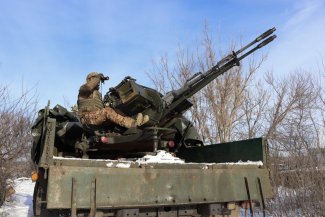Ukrainian troops stabilise the frontline west of Avdiivka. Day 740 of the war


A series of Ukrainian counterattacks in early March halted the enemy advance from the direction of Avdiivka, but nevertheless the Russians managed to partially capture the second line of villages west of this town. The reserves brought into action by the Ukrainians helped to push the invaders out of some areas of the towns of Berdychi, Orlivka and Tonenke, which had been seized in the previous days, and thus to bring some relative stability to the frontline. Fighting for control of these localities and the areas lying between them is still ongoing. The main Russian thrust is directed at Semenivka, which lies on the hills on the western side of the line of ponds, and which they are trying to reach from two directions (from the north-east via Berdychi and the south-east via Orlivka).
By halting the Russian advance, and thus preventing their forces from quickly crossing the line of ponds west of Avdiivka, the Ukrainians have gained time to reinforce their second line of defence, which was decidedly weaker and virtually unfortified: according to some Ukrainian sources, the failure to invest in fortifications forced the former command headed by General Valerii Zaluzhnyi to try and keep hold of Avdiivka. It remains unclear whether the Russians will decide to bring additional units into the fight in order to resume the advance quickly, and once they have entered the range of hills to the west of the line of ponds, whether they will attempt to build on their success and move out into the operational space. Indeed, the relatively high tempo of the Russian operations to date (the Russians have occupied an area of nearly 100 km2 in the period of just over two weeks since the defenders started their withdrawal from Avdiivka) was not simply the result of Russian units going on the offensive. They took advantage of the relative weakness of the Ukrainian troops and their inability to organise an effective defence in unfavourable terrain conditions (initially along the Stepove-Lastochkyne-Sieverne line, and later along the Berdychi-Orlivka-Tonenke line).
Russian forces have made further advances west of Bakhmut, as well as north, west and south of Marinka. In the area around Bakhmut, fighting for Ivanivske is continuing along the T0504 road to Kostiantynivka. Within a week, about 50% of the area of this locality came under Russian control, and the invaders have now also advanced north of it towards Chasiv Yar. In the area of Marinka, the Russians have occupied the southern districts in Krasnohorivka, and have also entered the central parts of Heorhiivka and Mykhailivka.
The Ukrainian counter-attacks in the area failed, but they did succeed in pushing the Russians out of parts of Robotyne, south of Orikhiv. The south-eastern part of this locality is now under the invaders’ control, and according to some sources, they have regained the positions they lost during the previous days. Russian forces also moved out to the outskirts of the village of Terny on the Zherebets river west of Kreminna. The attempt by a subunit of the Ukrainian Special Operations Forces to make a landing on the Tendra Spit in Kherson oblast was unsuccessful.
Commander-in-Chief of the Ukrainian army General Oleksandr Syrskyi placed the responsibility for the failures at the front on the commanders of some of the units fighting there, and threatened to dismiss those who were assessed negatively. On 29 February, he stated that in the course of an ongoing audit, “Some miscalculations in the management of the situation and assessment of the enemy were detected in some commanders, which directly affected the stability of the defence in some directions”. On 2 March, he reported that groups of professional advisers had been sent to brigades experiencing staff problems to pass on their experience and provide assistance. In cases where “the commander is not in control of the situation, and his actions and orders pose a direct threat to the life and health of his subordinates”, Syrskyi announced that “personnel decisions” would be taken. At the same time, he reported that all the necessary decisions had been taken to provide brigades with reserves, ammunition, drones and other equipment. He also listed those units which had positively distinguished themselves from the others: the 25th Airborne Brigade and the 47th Mechanised Brigade, which showed courage and determination in the battles for Orlivka and Berdychi; the 79th Air Assault Brigade, which repelled enemy attacks in the Novomykhailivka area; and the 54th Mechanised Brigade, whose soldiers destroyed two enemy columns.

The latest waves of Russian missiles and kamikaze drones mainly struck the frontline zone in Donetsk oblast, targeting the Ukrainian forces’ immediate hinterland. Pokrovsk was attacked twice with ballistic missiles (28 February and 3 March), while missiles from S-300 systems hit Kostiantynivka (1 March) and Myrnohrad (3 March). Shahed drones attacked Kharkiv (2 March) and Odesa (28 February and 2 and 5 March), among other locations. On 2 March one of them hit a residential building in Odesa, causing the deaths of 12 people, including children. According to Ukrainian sources, between the evening of 27 February and the morning of 5 March, the invaders allegedly used a total of 35 missiles, of which the defenders shot down three, and 53 Shahed-136/131 drones; although the Russians have been using their locally produced, modified version named Geran, the Ukrainian Air Force Command still uses the Iranian name. The Ukrainians reported the shooting down of 46 Shaheds.

In early March, Ukrainian forces launched further missile and drone attacks into occupied Crimea. Targets included the Belbek and Gvardieyskoye airfields (1 March), Feodosia (3 March) and the Crimean Bridge (5 March). In the attack on 5 March, the small missile corvette Sergey Kotov (which Russian nomenclature describes as a project-22160 patrol ship) operating in the Kerch Strait was sunk; Ukrainian military intelligence claimed responsibility for organising the attack. It is the first active Kalibr missile carrier to be eliminated by the Ukrainians (previously, the submarine Rostov-na-Donu, which was undergoing dry-dock repairs, and the missile corvette Askold, which was in the process of final outfitting, were damaged in Ukrainian attacks. The Russian Black Sea Fleet currently has 17 different class Kalibr carriers at its disposal.
The 3 March attack was one of the largest so far (according to Moscow, the Ukrainians used 38 kamikaze drones in it), but nevertheless it did not cause significant damage; all the drones were neutralised, and the remains of one fell on the territory of a fuel base. On 2 March, Ukrainian drones attacked the city St Petersburg, but likewise failed to cause any significant damage. The Ukrainian defenders also continued their attacks on the border regions of the Russian Federation; on 5 March, a Ukrainian drone caused a fire at a fuel depot in the town of Gubkin in Belgorod oblast.
On 29 February, Ukrainian hackers launched a successful attack on Russia’s largest internet portal Mail.ru, resulting in restricted access to the email service for 24 hours.
On 4 March, Ukrainian military intelligence reported a hacker attack on the servers of the Russian defence ministry. It resulted in the acquisition of information encryption software and secret documents that were transmitted to the ministry by more than 2000 Russian army entities.

On 27 February, the Intelligence Committee under the President of Ukraine warned that Russian services were implementing a plan of sabotage activities, information operations and provocations designed to undermine Ukraine's defence potential. The main objectives are to disrupt mobilisation, spread disinformation about the Ukrainian state’s inability to achieve military success, and to create and spread false reports to Western partners designed to deepen their ‘Ukraine fatigue’ and contribute to a reduction in support. The Russians want to demoralise Ukrainian society, sow panic in it, drive a wedge between the military and the civilian population, and create conflict between the country’s political leadership and the representatives of civil society. According to the Committee, in November last year, Russia spent almost $250 million on such activities via the Telegram messenger as part of a special operation called ‘Maidan-3’. The total budget of the operation to date has amounted to around $1.5 billion. According to Kyiv, the Russian operations will reach their climax in March-May this year.
On 28 February, the secretary of the National Security and Defence Council of Ukraine, Oleksiy Danilov, confirmed that Russia has intensified its disinformation campaigns aimed at sowing discord and influencing public opinion in European countries. As he put it, Russian trolls are spreading 166 million disinformation posts about Ukraine per week on platforms such as Telegram, Facebook, Instagram and X (Twitter). He added that the Russians are using artificial intelligence to interfere in the UK and US elections.
On 29 February, Ukrainian military intelligence (HUR) spokesman Andriy Yusov relayed that his organisation has lists of individuals who work with Russian special services in spreading rhetoric designed to aggravate the socio-political situation. He added that the adversary is creating new channels on the Telegram messenger on a mass scale, and organising bot farms to promote the Russian narrative. On 1 March, Yusov claimed that the anti-Ukrainian campaign was being led by the first deputy head of the Russian presidential administration Sergey Kiriyenko, as well as Vladimir Putin's former adviser Vladislav Surkov.

On 1 March in Kharkiv, President Volodymyr Zelenski and Dutch prime minister Mark Rutte signed an agreement on security cooperation. The Dutch side pledged to provide €2 billion in military aid in 2024, and to provide further military assistance over the next 10 years. Artillery, air defence and the Ukrainian Air Force were identified as priority areas for support. The Netherlands said it would support Kyiv's efforts to bring the aggressors to justice, as well as Ukraine's ‘future’ membership of the EU and NATO. The agreement is the seventh bilateral document guaranteeing long-term security support for Kyiv (similar ones were previously signed with the UK, Germany, France, Denmark, Italy and Canada).





